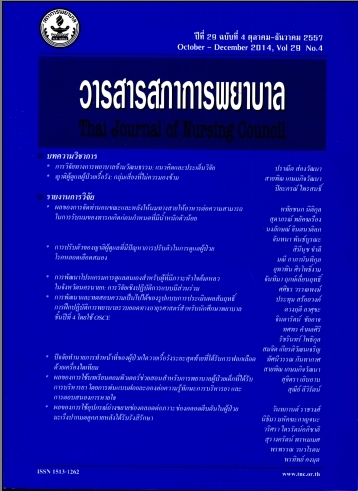ผลของการจัดท่านอนขณะและหลังให้นมทางสายให้อาหารต่อความสามารถในการรับนม ในทารกเกิดก่อนกำหนดที่มีน้ำหนักตัวน้อย
Keywords:
ท่านอน/ความสามารถในการรับนม /ทารกเกิดก่อนกำหนดน้ำหนักตัวน้อย, lying positions, feeding tolerance, low birth weight premature infantsAbstract
บทคัดย่อ: วัตถุประสงค์ของการวิจัย: เพื่อเปรียบเทียบความสามารถในการรับนมในทารกเกิดก่อนกำหนดที่มีน้ำหนักตัวน้อยระหว่างอยู่ในท่านอนคว่ำศีรษะสูง 30 องศา ท่านอนตะแคงขวาศีรษะสูง 30 องศา และท่านอนตะแคงซ้ายศีรษะสูง 30 องศาในนาทีที่ 120 และ 180 หลังให้นมทางสายให้อาหาร
การออกแบบวิจัย: การวิจัยเชิงทดลอง แบบกลุ่มเดียวไขว้กัน (Crossover clinical trial)
การดำเนินการวิจัย: กลุ่มตัวอย่าง คือ ทารกเกิดก่อนกำหนดที่มีน้ำหนักตัว 1,000-2,500 กรัม ที่เข้ารับ
การรักษาในสถาบันสุขภาพเด็กแห่งชาติมหาราชินีและมีคุณสมบัติตามเกณฑ์ที่กำหนด จำนวน 25 คนโดยทารกกลุ่มตัวอย่างได้รับการจัดท่านอนวันละ 3 ท่านอน ท่านอนละ 3 ชั่วโมง เป็นเวลา 3 วันตามลำดับท่านอนที่สุ่มได้ เก็บรวบรวมข้อมูลในนาทีที่ 0,120 และ 180 วิเคราะห์ข้อมูลด้วยสถิติบรรยาย การทดสอบคอครอน คิว (Cochran Q test) และการทดสอบความแปรปรวนแบบวัดซ้ำ (repeated measures ANOVA)
ผลการวิจัย: ทารกในท่านอนคว่ำศีรษะสูง 30 องศาตะแคงขวาศีรษะสูง 30องศาและตะแคงซ้ายศีรษะสูง 30 องศมีความสามารถในการรับนมเมื่อวัดในนาทีที่ 120 และ 180 หลังให้นมทางสายให้อาหารแตกต่างกันอย่างมีนัยมีนัยสำคัญทางสถิติ (Q120 = 8.727, Q180 = 7.00, p<.05) โดยนาทีที่ 120 ท่านอนตะแคงขวาศีรษะสูง 30 องศา ทารกสามารถรับนมได้ดีมากกว่าท่านอนคว่ำ 30 องศาและตะแคงซ้ายศีรษะสูง 30 องศา ตามลำดับ และในนาทีที่ 180 ท่านอนคว่ำศีรษะสูง 30 องศาทารกสามารถรับนมได้ดีมากกว่าท่านอนซ้ายศีรษะสูง 30 องศาและตะแคงขวาศีรษะสูง 30 องศาตามลำดับ
ข้อเสนอแนะ: พยาบาลควรนำการจัดท่านอนลักษณะศีรษะสูง 30 องศานี้มาใช้เป็นแนวปฏิบัติขณะและหลังให้นมทางสายให้อาหารแก่ทารกเกิดก่อนกำหนดที่มีน้ำหนักตัวน้อย โดยจัดท่านอนตะแคงขวาศีรษะสูง 30 องศาในช่วง 120 นาทีแรกของการให้นมทางสายให้อาหารและจัดท่านอนคว่ำศีรษะสูง 30 องศาในช่วง 120 ถึง 180 นาทีของการให้นมทางสายให้อาหารเพื่อช่วยส่งเสริมความสามารถในการรับนมของทารกเกิดก่อนกำหนดที่มีน้ำหนักตัวน้อย
Abstract
Effects of Low Birth Weight Premature Infants’ Lying Positions during and after Tube Feeding on Their Feeding Tolerance
Objective:
To compare the feeding tolerance of low birth weight premature infants when arranged in three lying positions, each with their heads raised to 30 degrees: (i) a prostrate position; (ii) on their right side; and (iii) on their left side, at the 120th and 180th minutes after tube feeding.
Design:
Crossover clinical trial.
Implementation:
The subjects were 25 premature infants weighing 1,000 to 2,500 grams being treated at Queen Sirikit National Institute of Child Health and possessing the required qualifications. Every day for a period of 3 days, the infants were arranged in 3 lying positions in a randomised order, each position for 3 hours. Data were collected on 0, 120 and 180 minutes and were analysed based on Cochran Q test and repeated measures ANOVA.
Results:
Significant differences were observed between the infants arranged in the prostrate, right-side-down and left-side-down positions with their heads raised to 30 degrees, at the 120th and 180th minutes (Q120 = 8.727, Q180 = 7.00, p < .05). At the 120th minute, the infants lying on their right side showed the highest feeding tolerance, followed by those in the prostrate and left-side-down positions, respectively. By contrast, at the 180th minute, the infants in the prostrate position showed the highest feeding tolerance, followed by those in the left-side-down and right-side-down positions, respectively.
Recommendations:
Nurses are advised to apply these 30-degree raised-head positions to the tube-feeding process for low birth weight premature infants. The right-side-down position is recommended for the first 120 minutes after tube feeding and the prostrate position for the period between the 120th and 180th minutes, as a means of increasing these infants’ feeding tolerance.






